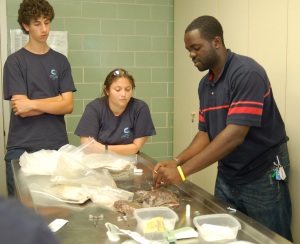Understanding Fish Populations
August 17, 2009 at 11:02 am | Posted in Uncategorized | 2 CommentsTags: flounder, interns, monkfish, tagging
Hello readers,
It’s Josh.
Today, we were given a lecture by Larry Alade, about his job at NOAA (National Oceanic and Atmospheric Administration) National Marine Fisheries Service. It was interesting how his background in computer science, biology, and math came together in fisheries science: he uses mathematical models to predict the population of fish. This involves in-depth knowledge about the behavior of a specific fish: what they eat, if they migrate, their predator/prey relationships, etc. He uses tracking devices to study their migration patterns and how that affects the fish stocks. This information on fish is used to assess how populations are doing, their movement and behavior, and what the possible effect fishing will have on them.

Larry Alade shows us how to tag a monkfish
Larry did a fish tagging demonstration for us with monkfish and flounder. To tag a monkfish, he made a small cut in the skin of the fish and inserted a bullet shaped tag between the skin and the muscle. To prevent infections and to keep the tag in place, he stitched up the incision. These tags will take the temperature and pressure readings of the water while the fish is swimming every ten minutes, for three years. To make a tagged fish more obvious to fishermen, they have yellow markers protruding from the fish, attached to the spine. The fish were surprisingly calm throughout all of this and barely moved during the whole five minute procedure.
Thanks for reading!
Josh
Blog at WordPress.com.
Entries and comments feeds.